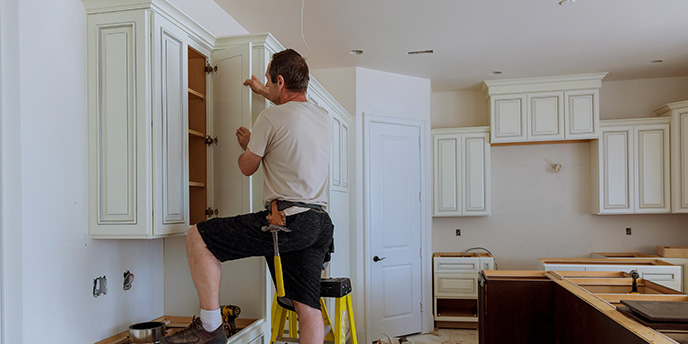Yes, it’s possible to install kitchen cabinets yourself, but it depends on your level of skill, experience, and comfort with DIY projects. Installing kitchen cabinets can be a complex task that requires careful planning and precision. Here are some general steps and considerations if you’re thinking about installing kitchen cabinets on your own:
Steps for DIY Kitchen Cabinet Installation:
- Measure and Plan:
- Measure the space carefully to ensure that the cabinets will fit.
- Plan the layout, taking into consideration the placement of appliances and other fixtures.
- Gather Tools and Materials:
- Collect all the necessary tools, including a level, tape measure, drill, screws, shims, and a stud finder.
- Ensure you have the right materials, such as the cabinets, screws, and any additional hardware.
- Remove Old Cabinets:
- If there are existing cabinets, remove them carefully, starting with upper cabinets before lower ones.
- Locate and Mark Studs:
- Use a stud finder to locate and mark the studs in the wall. This is crucial for securely anchoring the cabinets.
- Install Upper Cabinets:
- Begin with the upper cabinets. Use a level to ensure they are straight and level.
- Secure the cabinets to the wall studs using screws.
- Install Lower Cabinets:
- Install the lower cabinets, leveling them and securing them to the wall and to each other.
- Use shims as needed to ensure a level installation.
- Connect Cabinets:
- Connect adjacent cabinets with screws. Ensure that the seams are tight and level.
- Install Cabinet Hardware:
- Install handles, knobs, or pulls on the cabinet doors and drawers.
- Adjust Doors and Drawers:
- Adjust the doors and drawers for proper alignment. This may involve adjusting hinges or slides.
- Finish Touches:
- Complete any additional finishing touches, such as installing trim or molding.
Considerations:
- Skill Level: If you’re comfortable with tools and have some DIY experience, you may be able to handle cabinet installation. However, if you’re unsure or the project seems too complex, it might be best to consult a professional.
- Weight and Size: Cabinets can be heavy and awkward to handle. Having an extra set of hands can make the installation process smoother and safer.
- Time Commitment: Installing cabinets can be time-consuming, especially if you’re doing it for the first time. Be prepared to dedicate a significant amount of time to the project.
- Permits and Regulations: Check if there are any local building codes or regulations that require a professional installation or permits.
If you’re uncertain about your ability to install kitchen cabinets yourself, it’s wise to consult with a professional or hire a contractor to ensure a proper and secure installation. Properly installed cabinets are crucial for the functionality and longevity of your kitchen.


